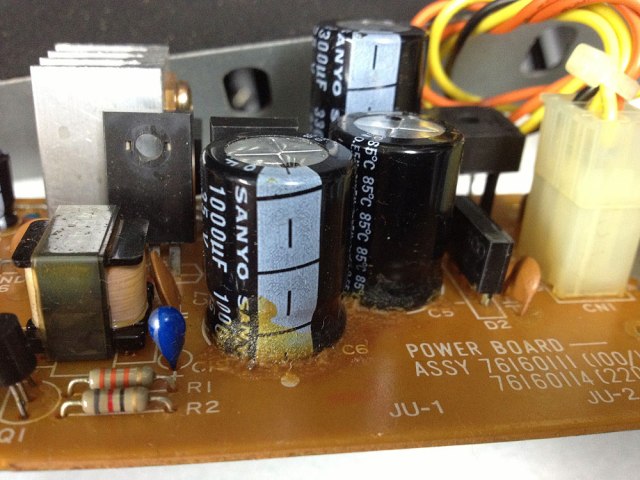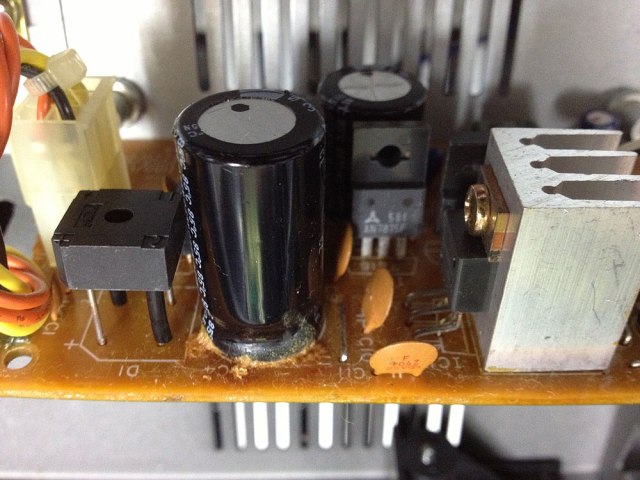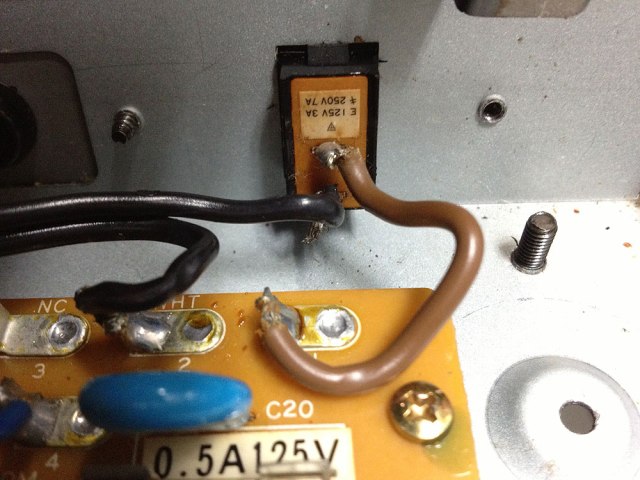
Hi everyone,
Recently I acquired my 3rd Roland Juno 2 synth for free because it simply wouldn’t turn on. The owner said it worked before putting it into storage, and then about a year later he turned it on and nothing happened. He gave it to me because he already had too many door stops…laugh. I thought maybe I could fix it, but it’s proven to be quite stubborn. Above is a photo of my work area where I’m currently testing the broken Juno-2 (bottom one) with a fully operational one above (top).
The Roland Juno-2 basically has never been opened. I open a lot of synths and I can tell that I’m the first one to crack it open. The Juno-2 is in excellent condition all around. When you flip the power switch it’s completely dead. No flicker, no heat, no noise, nothing. It’s like the power doesn’t even get to first base or even into the machine. I do try to repair my own synths, however I usually leave the Power supply area alone as that is not my strong point. Inside the Juno-2 seems pretty basic, so I thought I would scout around and see if I could find the problem in the hopes that it might be a simple fix.
I opened up the synth and inside everything seemed clean and connected. The power cable was fine, the switch looked good, along with everything else…BUT… the Electrolytic Capacitors looked funny to me on the Power Supply Board. Usually if they are bad I notice a bulging at the top, however the three capacitors on the power supply board look fine on top. The bottom however look like they could either be leaking or perhaps surrounded by a glue of sorts. I’m not sure which, although my guess it’s a leak. It’s kind of dull and crusty while glue is usually shiny and smooth.
My thoughts are that if the Electrolytic Capacitors are bad, that might be the reason the Juno-2 is not turning on, OR getting power to the rest of the synth from the Power Supply board. Otherwise, I have no idea why the Juno 2 will not power on.
Any ideas would be greatly appreciated.
Here are some photos.



UPDATE #1:
I wrote a comment below about the switch looking bad. Here is a photo. The wires are loosely soldered to the two plugs attached to the switch. The two plugs wiggle. On my other working Juno-2, the switch, plugs, and wires are rock solid with zero play.

UPDATE #2:
After using a Multimeter and checking for continuity all over the Juno-2, I’m finding zero problems. It really has me stumped. The only area I can seemed to properly check is the Power Transformer shown in the photo below. This sits in between the Power Supply board on the left and the Fuse board to the right. Both the Fuse and Power Supply Boards are 100%. Still when I turn on the Juno-2 below I get zero power past this Power Transformer. Could that be the cause? Not sure.

********** UPDATE #3 ***********
I’m getting close!!
I have discovered through swapping everything around with a working Roland Juno-2 that there is a definite problem on the MAIN BOARD. The battery has been changed and reset procedures have been done, but there is still no sign of life. There must be a broken connection somewhere and so I’m now consulting the Service Manual. Stay tuned!!

I dug out my other Roland Alpha Juno 2 which is working 100%. I removed the power supply board and swapped it with the one in the non-working Juno-2. It still wouldn’t power on which eliminates the power supply board as being the problem. I also put the power supply board from the attached photo into the working Juno-2 and all worked just fine.
I’m now thinking the problem “might” be where the on/off switch is connected to two wires, a brown and black one. With my working Juno-2 both wires are solidly attached and soldered in there very well. With the broken Juno-2, the bottom black wire is pretty solid, but the top brown wire is still attached, but barely. I’m going to warm up the existing solder and try to better connect that top wire. Power isn’t getting into the synth at all. Perhaps that’s because either the power switch or the connection between the switch and the switch board is at fault. Unfortunately I can’t remove the transformer and switch board without desoldering the two wires connected to the on/off switch. Otherwise I’d swap that with working components from my other Juno-2.
I already swapped the fuse for a new one which didn’t do anything. Thus that was eliminated from the puzzle.
I’ll update my post after re-soldering the wires.
I remember putting a white dot on my power connector, which I since then keep on top. I did that after I had power problems as well. The ‘odd’ position just didn’t seem to work as before. Odd, ain’t it? I can’t figure out anything else then a bad plug.
Hello there! Thanks for the comment.
On all of my Juno-2 synths, the power plug actually runs through a hole in the back and is soldered to the switch and fuse board. There is no way, barring the desoldering of the cable plug itself, to remove the power plug. I believe on the Juno-1 and perhaps even the HS80 you can do that, but not on my Juno-2 synths. So, to replace the plug I would have to desolder it and then solder a new one.
I also check the plug and cable and it’s practically brand new. I may just solder in a new plug just to eliminate that as a possibility because you never know. However, I still think likely the problem is with the transformer. Although it doesn’t look burned in any way, it definitely is not allowing any power through it. Strange.
Here is what the power switch looks like.
Power Switch WK2A44 3A
The Roland Juno-2 will still not power on.
1. The fuse has been replaced.
2. The on/off switch has been replaced.
3. A working Power Supply Board has been installed.
However, there is still no noise, LCD screen, LED lights, Heat, or anything to suggest that power is getting to anywhere on the Juno-2. Strange.
Currently I’m using multimeter to do a continuity test.
Did you check the transformer for AC output voltage? It seems that you have sorted out everything in front of the transformer for it to have 110 VAC and also the replacement of the power supply board is the first step after the transformer. CN1 pins 6, 7, and 8. on the power supply board.
Hi Rich. The power supply board is fine as I swapped it with a working one from my other Juno-2. I’m basically not getting any power after the transformer, so I think it’s the transformer unfortunately.
I’m not good enough to actually judge here, but I know where the folks with lots of experience hang out. Check the retro-computing forums, like lemon64, forum64 etc. There are lots of guys there repairing old c64s etc. They deal with rotten capacitors everyday.
Thanks Andreas! I’ll check out those forums for sure.
Dear Jim Hope you find the following useful: (refer to photo 2) The CAPS look OK, residue at bottom is aging glue. 1. With power on, measure the AC voltage on the secondary wires (red and yellow from the main transformer) If NO reading, replace main transformer.2. If there is a reading, check the bridge rectifier next to top capacitor for dead diodes, also check for a DC reading after the rectifier. If NO, replace.3. Trace the tracks from the rectifier to the CAPS through to the Small transformer on the left of the bottom CAP. Check for DC reading 4. Also test the transistor and voltage regulators opposite the small transformer.5. Also check for CRACKS in the circuit current path. I had the same problem with Roland E500, after testing found the small transformer fried – very scarce component. I’ve included Rawwrite for writing Roland S7XX .out files to 1.44mb floppy disks. Hope to hear from you soon
Date: Tue, 4 Feb 2014 05:41:35 +0000 To: jnfhart@hotmail.co.za
Thanks John! I checked the AC voltage on the secondary wires you mentioned and there is no reading. I believe the main transformer is not functioning. Unfortunately that transformer is hard to find, so I’m currently scouting around for another broken Juno-2, but with a working power transformer. It shouldn’t be too hard to find as most Juno-2 synths have problems with their keys, joystick, and other areas. What’s interesting though is when I ponder what might have caused that transformer to blow. The Fuse is good and everything else looks fine. Strange. Anyways, thanks very much for the comments and info. Much appreciated.
Thanks everyone for the great comments and tips. I still haven’t solved the issue, BUT it’s not much of a loss as I can definitely use the 3rd Juno-2 for parts. What’s very interesting though about this Juno-2 is that it’s absolutely in “like new” condition. I took a step backwards for a moment and surveyed the synth. I hadn’t noticed before, but I can now see that the keys are immaculate. They very white and shiny, plus they are a bit stiffer when playing. My other Juno-2 synths have yellow-ish keys and they look a tiny bit different. For a moment I thought perhaps the keybed might have been swapped out for another one. The recent Juno-2 looks newer and less played for sure. It really doesn’t look like anyone played this Juno-2 for very long.
Another thing is that the body and everything inside is absolutely in excellent condition. It leaves me scratching my head more because I can’t believe such an in shape looking synth won’t work. At least I can use the keys, joystick, and LCD for parts. Note I did in fact swap the main board, power supply board, and LCD out with my other working Juno-2. The boards appear to work fine. This also, along with continuity testing leads me to believe the Transformer is toast.
Anyways, I see these Juno-2 synths a lot in Japan and perhaps later on, I’ll find another with a working Transformer but broken in some other way. I can mix the two and get a working Juno-2.
have original transformer swaped while Vin voltage mod. contact if you still want it chyzh51@hotmail.com
hi Jim!
This is normally a “contact glue” (word by word translation from German. So I think that the caps are OK. Is there a fuse in the mains socket or on the power board?
Ciao
Peter
maybe the service manual can help finding the fault: http://www.synfo.nl/servicemanuals/Roland/JUNO-2_SERVICE_NOTES.pdf
ciao
Peter
Hi Peter! Thanks for the service manual. I already have one but will definitely NEED to study it after today. This morning I gutted the entire synth and one by one placed parts from the non-working Juno-2 into a working Juno-2. I then turned on the working Juno-2 to check each and every component. I found that neither Juno-2 would power on when the “newer” Main Board was installed. Thus I can say now with 100% certainty that the problem is on the Main Board. I changed the battery and still no sign of life. Now I’ll have to check the Service Manual to determine where on that Main Board, a problem could cause the entire Juno-2 to not power on.
Usually if a chip or other component goes bad, you get some sort of life in the form of a garbled LCD screen or LED lights flashing. Sometimes you even get sound. The fact that there is no sign of life, makes me believe power from t he power supply is not moving through the Main Board properly. I’ll have to again check for continuity while looking at the Service Manual. Thanks again and I think I’m a bit closer. I at least now know the area of the problem. I just need to pinpoint it now.
I have one in the same condition doing the same exact thing. The weird thing is, I fired it up at the pawn shop and it worked great. Get it home and nothing… Did you ever figure out what it was?
Hi Jim,
If you find that it is the transformer, I figured out a way to use two smaller transformers to power up the unit instead of finding a second hand part (which seem to be like hens teeth!). I similarly bought a japanese juno2 off of ebay and had the same issues. I used my working juno2 to test the power supply. After a couple of months of reading up on transformers and such, plus recording the voltages from each of the windings, I bought two transformers off of ebay. One with a 9v output and one with a 36v centre tap output, they both output 150mA each and all up cost me $30 – $40 including postage. It fired up straight away and I just had to remove the bolts that hold down the original transformer to fit a new plate that held the new ones neatly inside the case.
Now I have modded it to run both of them as a dual oscillator synth and they are controlled by a BCR2000, it sounds 10 times better now!
I hope this helps Jim, this was the first post about a broken juno that google sent me too and I was hoping you managed to find out your issue before me to save me the headache 😀
Anyway, good learning curve.
Best of luck with it all..
Paul
Hi everyone. Im looking for the following keyboards. Roland E-500 and Roland E-68 or E-300. Please help im desparetely in need.
Hi there…we have an E-300 that will not power up and I came across your post. Are you looking to purchase one or something?
A bit late in the game, but I figure my experience with transformers could be of help. Very often underneath the pvc insulation on these buggers, there is a thermal fuse. It is a square or rectangular little thing with 2 soldering prongs. Try to spot it underneath the insulation. Once you find it, carefully cut the insulation layer per layer and peel it away until you get to those prongs.
Measure if you get continuity over those prongs. If not, solder a wire bridge over them. Reinsulate the lot and test. Very possibly you will get a secundary AC voltage again. Good luck!
Did you manage to bring this to life?
have original transformer suitable for US 117input swaped while 220Vin voltage mod. contact if you still want it chyzh51@hotmail.com